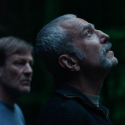A public telephone rings, unanswered, in the middle of the desert; a young girl pushes her grandmother in a rusty wheelchair, jerkily inching their way across the flat red expanse of the outback; a boy digs deep into the sand and lies brownly submerged in water the colour of his skin. The winner of last year’s Caméra d'Or for Best First Feature at Cannes, Samson and Delilah has bucked recent trends in Australian film, having already achieved substantial success both at home and abroad. It’s the least romantic love-story you’ll see all year, but probably also the least cynical.
The story of two Aboriginal teenagers and their struggle to find a place to belong, the film - made on a budget of just $AU1.2million (£600,000) - is by no means an easy watch. Set among the Warlpiri community of the Central Australian Desert, this first feature from the indigenous director Warwick Thornton combines minimal dialogue with a deformed skeleton of a boy-meets-girl plot that's warped by the incursions of drug-abuse and social alienation. The flesh of the film is all visual, fat with delicately framed images and extended visual sequences. Rather like the pointillist Aboriginal dot paintings that Delilah and her grandmother produce, these remain perpetually isolated from one another – an abstract tapestry of colours that demands the viewer stand well back to make sense of the whole.
At root a film about forging connections, Samson and Delilah uses its young hero’s stammer both as a metaphor for a community’s lack of voice and – more interestingly – as a stylistic tool. Denied the expositional crutch of dialogue, the cinematography (also by Thornton) shows rather than tells, loading each frame with visual narrative. Speech, where it occurs, collapses into one-sided conversations, misunderstandings and arguments, and violence becomes the disturbingly devalued currency of communication. One of the film’s most emotive moments is the scrawled "S4D" on a Portakabin wall: Samson’s wordless and only declaration of his love for Delilah.
It was W H Auden who famously begged to be told “the truth about love”. In the generous and unblinking narrative of Samson and Delilah, Thornton has gone a long way toward framing an answer. It’s a love story in its unrefined state, raw and saccharine-free.















Add comment